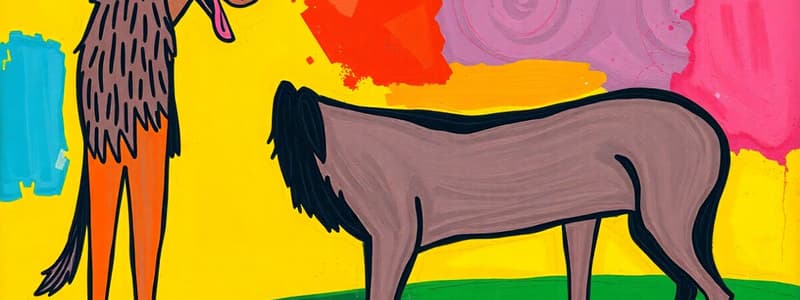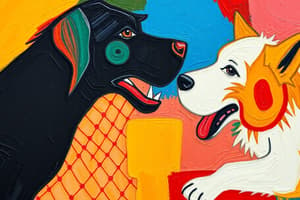Podcast
Questions and Answers
Which statement accurately reflects the behaviorist perspective on learning?
Which statement accurately reflects the behaviorist perspective on learning?
- Emotional intelligence and self-awareness are the key factors in behavior changes.
- Learning is primarily driven by innate cognitive structures and processes.
- Unconscious desires and motivations are the main drivers of behavior and learning.
- Observable behaviors are the primary focus of study, with less emphasis on internal mental states. (correct)
How would Pavlov's classical conditioning explain a dog's fear of thunderstorms?
How would Pavlov's classical conditioning explain a dog's fear of thunderstorms?
- The dog has a cognitive understanding that thunderstorms can be dangerous.
- The dog has learned to associate the sound of thunder and sight of lightning ($CS$) with an unpleasant experience ($UCS$), such as a loud noise or feeling of static, leading to fear ($CR$). (correct)
- The dog has a genetic predisposition to fear loud noises and flashing lights.
- The dog is exhibiting a spontaneous recovery from a previously extinguished fear response.
In classical conditioning, what occurs during the extinction process?
In classical conditioning, what occurs during the extinction process?
- The unconditioned stimulus is removed, leading to a gradual decrease in the conditioned response. (correct)
- The subject demonstrates a sudden, unpredicted increase in the conditioned response.
- The conditioned stimulus is repeatedly paired with the unconditioned stimulus to strengthen the association.
- A novel stimulus is introduced to create a more complex conditioned response.
What real-world example best illustrates stimulus generalization?
What real-world example best illustrates stimulus generalization?
How does Thorndike's Law of Effect influence behavior, and how does it differ from classical conditioning?
How does Thorndike's Law of Effect influence behavior, and how does it differ from classical conditioning?
In operant conditioning, what is the primary difference between positive reinforcement and negative reinforcement?
In operant conditioning, what is the primary difference between positive reinforcement and negative reinforcement?
What is the key distinction between fixed interval and variable interval reinforcement schedules?
What is the key distinction between fixed interval and variable interval reinforcement schedules?
How did Tolman’s work on cognitive maps challenge traditional behaviorist views of learning?
How did Tolman’s work on cognitive maps challenge traditional behaviorist views of learning?
Which statement best describes Bandura’s concept of observational learning?
Which statement best describes Bandura’s concept of observational learning?
What are the four necessary conditions for effective modeling in social learning theory?
What are the four necessary conditions for effective modeling in social learning theory?
How does Gestalt psychology differ from behaviorism?
How does Gestalt psychology differ from behaviorism?
What is the main principle behind the Gestalt Law of Proximity?
What is the main principle behind the Gestalt Law of Proximity?
How does insight learning, as demonstrated by Köhler's experiments with chimpanzees, differ from trial-and-error learning?
How does insight learning, as demonstrated by Köhler's experiments with chimpanzees, differ from trial-and-error learning?
How accurate conclusions are drawn by observing both overt (observable) and covert (covered/ not readily observed) behavior?
How accurate conclusions are drawn by observing both overt (observable) and covert (covered/ not readily observed) behavior?
Why is Dale's Cone of Experience arranged with concrete experiences at the bottom and abstract experiences at the top?
Why is Dale's Cone of Experience arranged with concrete experiences at the bottom and abstract experiences at the top?
What is the significance of live models in social learning theory?
What is the significance of live models in social learning theory?
Which of the following describes a scenario of negative punishment in operant conditioning?
Which of the following describes a scenario of negative punishment in operant conditioning?
In the context of classical conditioning, how does discrimination differ from generalization?
In the context of classical conditioning, how does discrimination differ from generalization?
Albert Bandura's social learning theory posits that learning occurs within a social context. How does this perspective differ from Skinner's operant conditioning?
Albert Bandura's social learning theory posits that learning occurs within a social context. How does this perspective differ from Skinner's operant conditioning?
In classical conditioning, spontaneous recovery refers to what phenomenon?
In classical conditioning, spontaneous recovery refers to what phenomenon?
Flashcards
Behaviorist Perspective
Behaviorist Perspective
Focuses on studying observable, measurable behavior, emphasizing learning through conditioning and reinforcement.
Ivan Pavlov
Ivan Pavlov
Russian psychologist known for classical conditioning, demonstrated by his experiment with meat, a dog, and a bell.
Classical Conditioning
Classical Conditioning
A neutral stimulus (bell) becomes associated with an unconditioned stimulus (meat), leading to a conditioned response (salivation).
Stimulus Generalization
Stimulus Generalization
Signup and view all the flashcards
Extinction
Extinction
Signup and view all the flashcards
Spontaneous Recovery
Spontaneous Recovery
Signup and view all the flashcards
Discrimination (in conditioning)
Discrimination (in conditioning)
Signup and view all the flashcards
Edward L. Thorndike
Edward L. Thorndike
Signup and view all the flashcards
Law of Effect
Law of Effect
Signup and view all the flashcards
Law of Exercise
Law of Exercise
Signup and view all the flashcards
John Watson
John Watson
Signup and view all the flashcards
Experiment on Albert
Experiment on Albert
Signup and view all the flashcards
B.F. Skinner
B.F. Skinner
Signup and view all the flashcards
Operant Conditioning
Operant Conditioning
Signup and view all the flashcards
Positive Reinforcement
Positive Reinforcement
Signup and view all the flashcards
Negative Reinforcement
Negative Reinforcement
Signup and view all the flashcards
Positive Punishment
Positive Punishment
Signup and view all the flashcards
Negative Punishment
Negative Punishment
Signup and view all the flashcards
Fixed Interval Schedules
Fixed Interval Schedules
Signup and view all the flashcards
Variable Interval Schedules
Variable Interval Schedules
Signup and view all the flashcards
Study Notes
Behaviorist Perspective
- Focuses on observable and measurable behavior
- Behavior is learned through conditioning and reinforcement
- Does not focus on the mind and thought process
- Famous theorists include Pavlov, Watson, Thorndike, and Skinner
Ivan Pavlov
- Russian psychologist
- Known for classical conditioning or stimulus substitution
- Renowned for experiment involving meat, a dog, and a bell
Pavlov's Experiment: Stage 1 - Before Conditioning
- Bell (neutral stimulus) -> no response
- Meat (unconditioned stimulus) -> salivation (unconditioned response)
Pavlov's Experiment: Stage 2 - During Conditioning
- Bell (neutral stimulus) paired with Meat (unconditioned stimulus) -> salivation (unconditioned response)
Pavlov's Experiment: Stage 3 - After Conditioning
- Bell (conditioned stimulus) -> salivation (conditioned response)
Pavlov’s Other Features of Classical Conditioning
- Stimulus Generalization: a dog that salivates at the sound of one bell will salivate at similar sounds
- Extinction: salivation will stop if pairing of bell and food stops
- Spontaneous Recovery: extinguished responses can be recovered after time
- Discrimination: a dog distinguishes between bells that signal food and those that do not
- Higher-Order Conditioning: pairing a bell with food conditions a dog, a flashed light at the same time will eventually cause salivation to the light without the bell
Edward L. Thorndike
- Founded connectionism theory
- Gave the original Stimulus-Response (S-R) framework of behavioral psychology
- Learning results from associations between stimuli and responses.
- Associations or habits are strengthened/weakened by the nature/frequency of S-R pairing
Three Primary Laws of Connectionism
- Law of Effect: stimulus-response connection strengthens with positive consequence (reward), weakens with negative (punishment)
- Negative consequence only weakens behavior; it doesn't remove it
- Law of Exercise: more S-R bond is practiced, the stronger it becomes
- Law of Readiness: the more ready a learner is to respond to stimulus, the stronger the bond will be
Principles Derived from Thorndike’s Connectionism
- Learning requires both practice and rewards (law of effect/exercise)
- S-R connections can be chained together if they belong to the same action sequence (law of readiness)
- Transfer of learning occurs because of previously encountered situations
- Intelligence depends on the number of connections learned
John Watson
- Founder/Father of Behaviorism
- Believed so much in conditioning that he thought he could take any healthy infant and make them into anything
- Famous for experiment on little Albert
Experiment on Albert
- Applied classical conditioning involving Albert (a young child), white rat, and a loud noise
- Meant to help understand fears, phobias, and prejudices
- Stage 1 - Before Conditioning: White rat (neutral stimulus) -> no response; Loud noise (unconditioned stimulus) -> crying (unconditioned response)
- Stage 2 - During Conditioning: White rat (neutral stimulus) paired with loud noise (unconditioned stimulus) -> crying (unconditioned response)
- Stage 3 - After Conditioning: White rat (conditioned stimulus) -> crying (conditioned response)
Burrhus Frederick Skinner
- Studied operant behavior (voluntary behaviors in operating the environment)
- Established Operant Conditioning
- Learning results in change in overt (observable) behavior
- Giving of reinforcement and punishment
Operant Conditioning
- Reinforcement: anything that strengthens the desired response
- Stimulus added to increase a behavior. Example: giving of tokens after providing the correct answer.
- Negative Reinforcement: Stimulus withdrawn or removed to increase a behavior. Example: Exempting you from the the exam after getting a perfect score in the previous test.
- Punishment: meant to reduce or weaken the response
- Positive Punishment: stimulus given or added to weaken a behavior. Example: giving extra homework after failing a test
- Negative Punishment: stimulus withdrawn or removed to weaken a behavior. Example: Confiscating gadgets after failing to do chores
Reinforcement Schedules
- Fixed Interval Schedules: reinforcement after a fixed amount of time; giving reward every 10 minutes
- Variable Interval Schedules: reinforcement after an indefinite amount of time; giving reward on random time
- Fixed Ratio Schedules: reinforcement after a fixed number of responses; giving reward every 10 correct answers
- Variable Ratio Schedules: reinforcement after an indefinite number of responses; giving reward with average of 10 correct answers
Neo Behaviorism
- Bridges the gap between behaviorism and cognitive theories of learning
- Prominent theorists are Tolman and Bandura
Edward Tolman’s Purposive Behaviorism
- Sign Learning Theory
- Founded on Gestalt and Watson’s behaviorism
- Organism learns by pursuing signs to a goal
- New stimulus (sign) becomes associated with meaningful stimulus (significance) through pairings
Tolman’s Key Concepts
- Learning is always purposive and goal-directed
- Cognitive Map in Rats: rats form cognitive maps in their mind which help them "learn the location" inside the maze and perform well
- Organisms select the shortest/easiest path to a goal
- Latent learning stays with the individual until needed and is not outwardly manifested
- Intervening variables can't readily be seen but determine behavior and are mediating variables
- Reinforcement is not essential for learning
Albert Bandura’s Social Learning Theory
- Learning occurs within a social context
- People learn from each other through observational learning, imitation, and modeling
General Principles of Social Learning Theory
- People learn by observing others’ behavior and their outcomes
- Learning can occur without a change in behavior
- Cognition plays a role in learning
- Social learning bridges behaviorist and cognitive learning theories
Types of Model
- Live Model: actual person demonstrating behavior
- Symbolic Model: person/action portrayed in media like TV, videotape, computers
Conditions Necessary for Effective Modeling
- Attention: paying attention to the model
- Retention: remembering the behavior
- Motor Reproduction: ability to replicate behavior
- Motivation: necessary conditions in repeating behavior
Cognitive Perspective
- Gestalt Psychology:studies cognition
- Considers the mental processes and products of perception
Gestalt Theory
- Focused on initial cognitive response to behaviorism
- Emphasized the importance of sensory wholes and the dynamic nature of visual perception
- The term means "form" or "configuration"
- Wertheimer, Kohler, and Koffka concluded that perceivers (learners) are active, not passive
- Learners don't just collect info, they actively process and restructure data
Gestalt Principles
- Law of Proximity: elements that are closer together will be perceived as one object
- Law of Similarity: similar elements will be perceived as part of the same form
- Law of Closure: filling in the gaps/ ignoring the gaps in the figure
- Law of Good Continuation: tendency to continue contours and move from on object to another drawing a good continuous line
- Law of Good Pragnanz: stimulus organized into a good or simple figure
- Law of Figure/Ground: tend to notice foreground first; stimulus will be perceived separately from its ground
Insight Learning
- First developed by Wolfgang Kohler
- Described from experiments with apes that used boxes and sticks to solve problems
- Apes could get a banana attached to the top of the chimpanzee’s cage
- Only Sultan, one of Kohler’s apes, was able to solve the problem
- Reinforcement wasn't an important part of learning: it's about the coordination of thinking to create new organization of elements for a greater understanding or insight
- Also referred as discovery learning
Kurt Lewin’s Life Space Concept
- Accurate conclusions are drawn by observing both overt (observable) and covert (covered/ not readily observed) behavior
- An individual has inner and outer forces that affect perceptions and learning
- Inner forces: motivations, attitudes, feelings
- Outer forces: motivations, society, peers, technology, etc
Theories and Principles in Educational Technology
- Dale’s Cone of Experience learning model was introduced by Edgar Dale
- It shows the abstract learning experience at the peak and progresses into the most concrete experiences down to the base
Studying That Suits You
Use AI to generate personalized quizzes and flashcards to suit your learning preferences.




